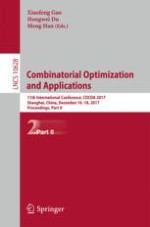The two-volume set LNCS 10627 and 10628 constitutes the refereed proceedings of the 11th International Conference on Combinatorial Optimization and Applications, COCOA 2017, held in Shanghai, China, in December 2017.
The 59 full papers and 19 short papers presented were carefully reviewed and selected from 145 submissions. The papers cover most aspects of theoretical computer science and combinatorics related to computing, including classic combinatorial optimization, geometric optimization, complexity and data structures, and graph theory. They are organized in topical sections on network, approximation algorithm and graph theory, combinatorial optimization, game theory, and applications.
